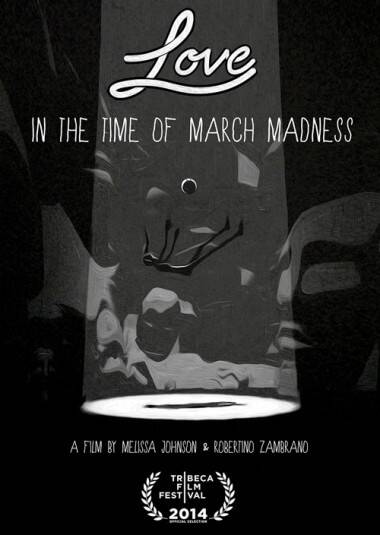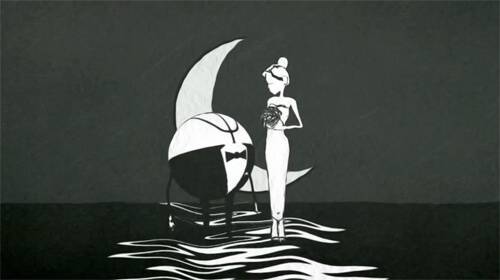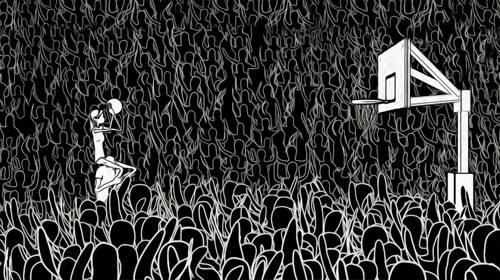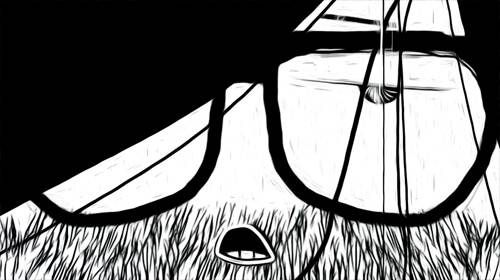‘Love in the Time of March Madness’ – an interview with directors Melissa Johnson and Robertino Zambrano
Love in the Time of March Madness has been soaring since its premiere last year, winning for Best Short Film (Online) at the Tribeca Film Festival and having been screened at festivals worldwide including the Encounters International Short Film Festival, Calgary International Film Festival and the Abu Dhabi Film Festival. The film is written and co-directed by Melissa Johnson, whose work in documentary filmmaking includes the Emily Tay documentary No Look Pass (2011), and Brittney Griner: Lifesize (2015). In March Madness Johnson turns the focus on her own recollections and personal conflicts as a 6’4″ basketball player prone to romantic misadventure, realised through the animation of co-director Robertino Zambrano, founder of Sydney-based KAPWA Studioworks. We got some time with both directors to discuss the film’s origins, its unique visual approach and co-directing across continents.
Having generally made films about other people, what made you decide to do something autobiographical this time around?
Melissa Johnson: I wrote this essay that did really very well for Salon. Right before it was published the editor said “Hey just brace yourself, because we have some pretty nasty trolls on our site, so prepare to eviscerated”. But I got a lot of positive feedback about it, pretty much all of the comments were nice! That was hugely encouraging, because of course the piece took a long time to write and was based off a lot of anecdotes, even more in the essay than in the film, which is a pared-down version of the essay.
So how did it go from being an essay to an animated short?
MJ: A friend of mine who worked at R/GA, an agency in New York, asked if I was thinking of doing anything else with it. I said I didn’t know any animators but felt like it might work as a little animated film, and he knew exactly who I had to meet – Robertino, who was also in New York at the time. Immediately it was like this creative kismet where the piece just really resonated with him.
So from there how did work on the film itself get started?
Robertino Zambrano: It’s really hazy now, but we probably started looking at a first draft of the script in 2010 or early 2011. Because I was doing it on the side we spent about a year just trying out a lot of different styles, really just taking the time and trying to work out what was the best approach for the script. A lot of these kinds of projects tend to start out a bit ambitious; I was working full-time at the time, so there was a lot of trimming down from all the things I wanted to do, which is obviously good in the end. I wanted to do it traditionally at first, we started out doing a lot of frame-by-frame animation tests. By then we had a fifteen minute script that we hacked down – I tried to get it to seven but I think we settled on around nine. That was when I thought I don’t think I’m gonna do this in 2D, let’s start doing some 3D and cheat our way through compositing to get it looking nice!
How faithful is the animated version to the original Salon essay?
MJ: You can see from reading the essay that it is quite faithful, it is a streamlined version because there are just more anecdotes and more detail in the essay than we could include in the film, but the same bone structure is there, for sure, and the same highlights are there. As a writer I had to really work on Okay, how can I tear down the words and trust the visuals to do the work? One example in the essay is I say explicitly “I feel like a walking Rorschach test” but in the film Robertino just took that on and was able to visually communicate it.
Did your approach to the production of this film differ at all from other projects you’ve worked on?
MJ: Keep in mind that the majority of this project happened when we had the Pacific Ocean in between us – I feel like Skype deserves a credit in the film, in terms of how we actually used it for communication when you don’t actually have the luxury of being in the same room with the other person, almost the entire time. I’ve been conditioned as an athlete to be on teams my entire life, and a lot of the fun of that is getting to banter with people and go back and forth in real-time, in person. So it was a challenge. We definitely surmounted it, but it was hard dealing at a greater distance, when you have to do a lot more co-ordination to figure out the timezones and when you can talk.
RZ: At the start I was very informal about storyboarding and doing all the layouts and everything. It was only as we started getting deeper into the production where I kind of really realized that I should have been as disciplined with this as with commercial work! When I decided to bring other animators on was when I realized that animating from your head is fine if it’s just you, but as soon as you need to start delegating and assigning tasks to a team you need to have a pretty solid production plan laid out, so that was a good kick in the bum for me.
In general has your corporate work been valuable to you as a filmmaker?
RZ: It really depends on the client. I guess there’s two sides to it – the bigger ocean is a lot of lower-budget, fast-turnaround work, especially now because of the web, where a lot of people want stuff pretty quickly and don’t want to spend that much money, but they still want something good. Then you have the other side with clients who are willing to spend, want a thorough creative process and want to pay for something that’s unique and has been really crafted and loved, and they’re great jobs to get. Right now I deal with both – hopefully that nicer side will continue to get bigger.
Apart from this film what are some of the projects you’ve both gotten the most out of?
RZ: The TED-Ed animation was nice because they just let you do whatever you want. That for me was a really enjoyable project, I got to try out some new techniques and I think for me it was the first time I’d just really tried some new stuff for a long time – it was called The Science of Stage Fright.
March Madness seems relatively simple on the surface, but watching it in motion reveals a lot more complexity to the animation. Can you talk us through the overall technique?
RZ: We built most of the raw elements – most of the characters and most of the main props – in Maya. There are a couple of shots in the film which are actually just 2D, done in Flash frame-by-frame, but the majority of it is generated through CG. We brought all the footage into After Effects and did all our compositing in there, adding any treatments and other little elements, backgrounds, layouts et cetera.
Something that came quite late in production was that I had always wanted to apply some sort of sketchy, painterly effect to all the animation. For The Science of Stage Fright I’d experimented with this kind of ink, oil-paint effect which worked out quite well,so I brought that back into this production. All it was really was that Photoshop has this oil-paint filter which looks really hokey if you just apply it straight-up to any image, but the thing I saw that it did which most effects didn’t do was it actually picked up a lot of the contours in the image, so you could extract some really cool painterly effects. So I adjusted the Maya render to take that into account and give me enough stuff to work with, as well as some digitally hand-generated textures mainly added in during the compositing phase just to help break up a lot of the more CG-looking elements.
 The post work in After Effects really goes a long way as far as blending the 2D and CG shots together.
The post work in After Effects really goes a long way as far as blending the 2D and CG shots together.
RZ: It really helped, especially when we had some of the more frame-by-frame Flash generated stuff, where I was like How are we gonna marry these two together? A lot of the scenes at the start, where they’re all coming out of Maya, were looking very 3D, so just a lot of it was trying to break up the perspective so it didn’t look so ‘nice’. When you get to that point where someone who’s watching it says “How did they make that?” you’ve done something right!
MJ: I just take my hat off to Robertino because he did all the hours upon hours of heavy lifting. There were times I felt like Man, we’ve reached a point where I can’t do anything to help. It became just a matter of him getting the hours to complete it. He just refused to compromise on quality at all, and I support him on that – once you get so far into it, for us it’s like there’s no backtracking on the standard set. You’ve gotta just continue it and finish it to that high degree, or the sacrifices you’ve made so far are for naught.
The other person I should mention in all this is our wonderful composer Albert Behar. Albert lives in New York City and I’ve worked with him on many of my films and actually did the voice performance for March Madness at his very hip Bed-Stuy apartment. Albert converted his bedroom into this sound studio with a really beautiful old-fashioned microphone, and I got into this like makeshift booth on the hottest day of the summer. It was just brutally hot, so hot that we would have to take breaks where we would put on the air-conditioning unit in his wall to cool down so we wouldn’t die, I’d practice my lines and then turn it off and do five or six minutes of recording. Then we’d turn the air conditioning back on and cool down again!
Albert was also part of the creative process. I know his music very well, when I heard what he came up with for March Madness it got my fired up: “Yep, that’s exactly right! That’s what I’ve been looking for”. Without question, I put myself in exactly the right hands, with Robertino and Albert.
Has being both an animated short and a documentary widened its exposure, would you say?
MJ: I feel like it has, it’s kind of emblematic of the metaphor of the film itself; I may be pushing it here a little bit, but what you see in our film is what you see in yourself, whatever you want to bring to it. We’re quite open to however you want to categorise us, I’m not hung up on that at all. But the perspective the audience brings to the film says, I think, a lot more about them.
RZ: It’s something I’ve thought about a lot, especially over the last few months since the film’s gone on its festival run. I’d always just thought that we’d enter this into the animation category, and then people were telling us to enter it into documentary categories. I feel like animation is almost more honest than a verbal storytelling approach, because you’re not choosing the perfect depiction of this story, rather you’re providing some sort of medium for the viewer to bounce off what the narrator is trying to tell.
MJ: For me it’s almost like the filmic equivalent of creative non-fiction; It’s a true story told in a narrative style, and the animation just amps that up. I love the grey area between scripted, narrative, performative, documentary – it makes me really excited.
To learn more about Love in the Time of March Madness visit KAPWA Studioworks at kapwa.co





